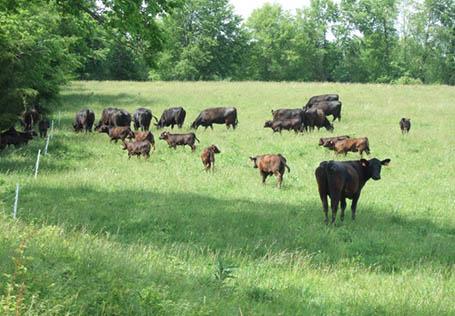Rotational Grazing: David Burge
 This summer the Master Grazer Educational program conducted several demonstrations across KY for producers to see best management practices in place, and the benefits they possess. One of these demonstrations was implemented in Anderson County by David Burge. He had always utilized a continuous grazing system but was looking for ways to improve his grazing management and maximize land utilization.
This summer the Master Grazer Educational program conducted several demonstrations across KY for producers to see best management practices in place, and the benefits they possess. One of these demonstrations was implemented in Anderson County by David Burge. He had always utilized a continuous grazing system but was looking for ways to improve his grazing management and maximize land utilization.
As part of the project, a portion of the farm was managed under continuous grazing and another portion in a rotational grazing system. Mr. Burge had about 18 acres that he wanted to use in the rotational grazing portion, and around 20 acres to remain under continuous grazing. The remainder of the farm was used for hay production, including some warm-season grasses he generally grazes as pasture. The herd was divided into 12 cow/calf pairs in the rotational grazing system and 9 cow/calf pairs in the continuous grazing system. When dividing the 18 acres for the rotational system he wanted 6 paddocks, each about 3 acres. The managed grazing method allowed Mr. Burge to have a higher stocking rate. On the rotational grazing paddocks he ran 1.5-1.67 acres per cow/calf pair at a given time, while the rate for the continuous paddock was 2.2 acres per cow/calf pair. Decreasing acreage needed per cow/calf pair allows producers to expand their herd, resulting in more calves to sell over time.
A field day was held on July 28, 2014, and Mr. Burge shared his experiences with rotational grazing; previously he had only used continuous grazing on this farm. He told participants that if he had divided each paddock in half, making a total of 12 paddocks, it would have been more effective. Mr. Burge told us, “The initial plan takes longer to layout than you would imagine, and it does take some thinking, but definitely worth the effort.”
Mr. Burge used two adjacent fields for his rotational grazing system. These fields had a permanent fence between them, and he then divided each field into three paddocks using temporary fencing materials. He told us “anyone looking to try this needs to use temporary fencing for the first couple years at least, so they can determine where fences should be.” After doing this exercise Mr. Burge stressed that a fenced alley accessible from all paddocks and leading to his handling facility would have been ideal. He faced a pinkeye challenge this summer and on multiple occasions had to get animals to the handling facility, and he said a fenced alley would have saved him a lot of time and kept him from having to separate the groups repeatedly. He also thought it would help having an alley because if the cattle were in the paddock farthest from the handling facility, he wouldn’t have to bring them through all the paddocks. It is important to note that under normal farm circumstances only one herd would have been on the farm which would have negated the importance of the alley. However, if farmers are managing replacement heifers or a group of weaned calves separately from the cow herd, then an alley would make management easier as Mr. Burge explained. The demonstration’s objective was to illustrate firsthand the benefits of managed grazing versus continuous. The best way to do this is to have the systems side-by-side to compare, which adds a few challenges.
Mr. Burge said, “Once you get it laid out well, it really is easy. The cattle learn the system within the first couple of rotations and after that they aren’t any trouble at all to move every 3 to 4 days.” Even though the cattle get used to the system, a good electric charger is a must. A problem he faced was dividing his cows and only having one bull. He said on multiple occasions his bull in the continuously grazed pasture would tear down the electric fence to get to the cows in heat in the rotational grazing system. Mr. Burge stated that he believed rotational grazing would work best if the herd wasn’t split to prevent this problem.
Fifty units of nitrogen per acre were applied to the rotational grazed pastures, as well as an herbicide to paddocks with excessive weed pressure. When asked about weed control in the rotational paddocks compared to the continuously grazed field, Mr. Burge said he believed that improved pasture management would drastically improve weed control within the first couple years, even without using an herbicide. Weed pressure was decreased for the rotationally grazed paddocks, even over the short duration of this demonstration. Another statement Mr. Burge made was, “A fundamental understanding of basic forages is needed to ensure that the cattle aren’t overgrazing the pastures, and you are moving them to the next paddock at the correct time.”
Mr. Burge told us that it was a fantastic learning experience and it was a pleasure to work with the Anderson County agent Tommy Yankey and the specialists at the University of Kentucky. He feels that rotational grazing can increase stocking rate if used effectively and that there is a benefit to using the method. For more information on rotational grazing practices and getting more days grazing from your pastures, contact your local extension agent or visit this website.
Categories:
General
Farm Highlights


